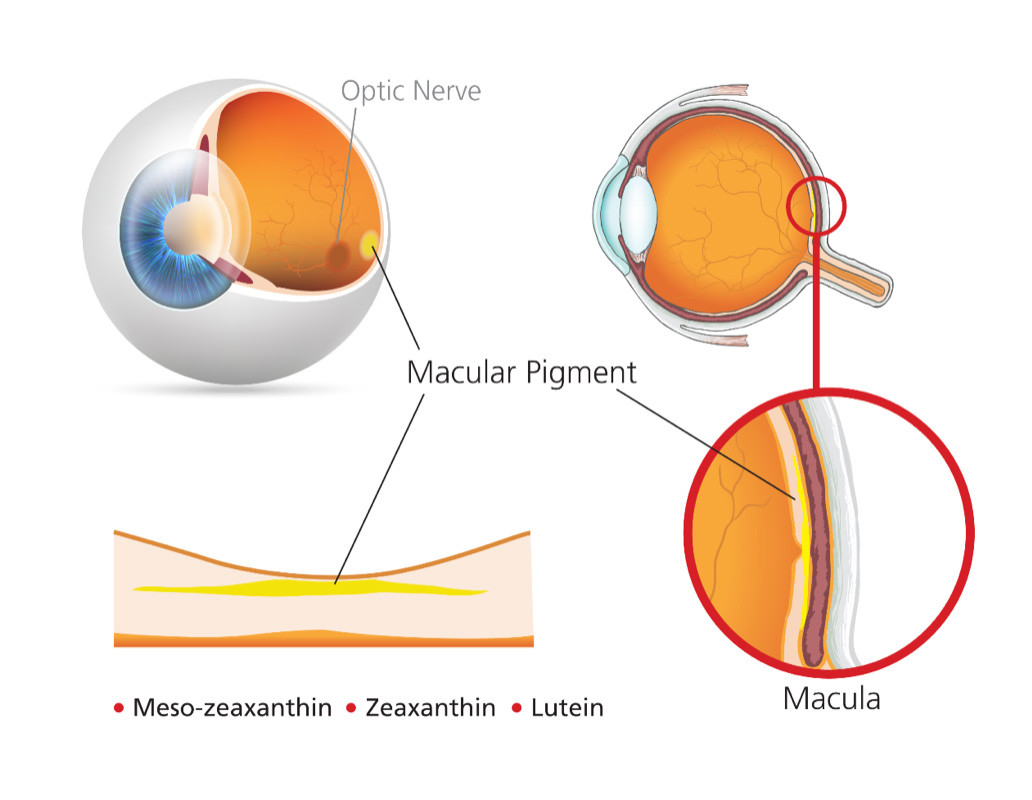The Macula and Macular Pigment
- The macula is the central and most specialised part of the retina, as it mediates central and colour vision
- Macular Pigment (MP) is a term used to describe a collection of three dietary carotenoids (pigments) located at the macula
- The three carotenoids Lutein (L), Zeaxanthin (Z) and Meso-Zeaxanthin (MZ) are found in equal concentrations at the macula
- MZ is the dominant carotenoid at the centre of the macula
- MP gives the macula its eponymous yellow colour

Functions of Macular Pigment
- MP is strategically located to exhibit protective and visual enhancing properties at the macula
- Unstable molecules, known as free radicals, are produced at the macula because of the high use of oxygen by this tissue in a process known as oxidative stress (this is a normal process of life, known as oxygen metabolism and increases as we age)
- Oxidative stress simply refers to tissue damage caused by free radicals (unstable molecules), which, in turn, are the result of high oxygen metabolism, and it is noteworthy that the human retina has the highest oxygen metabolism of any tissue in the mammalian world
- MP protects the macula from oxidative damage and supports photoreceptor health by reducing oxidative stress and free radical damage, because it has powerful antioxidant properties (just like sunscreen)
- The collective combination of MZ, L and Z provide the macula with superior antioxidant capacity compared to any of these carotenoids in isolation (they work together in synergy, so it is important to have all three of the macular carotenoids)
- MP reduces photo-oxidative injury at the macula by limiting the amount of short-wavelength (blue) visible light incident upon the photoreceptors
- Filtration of short-wavelength light at the macula optimises visual performance as it reduces the negative impact of light scatter, veiling luminance and chromatic aberration (MP enhances the internal optics of the eye)
- Optimisation of the internal optics of the eye, by filtration of blue light via MP, enhances contrast sensitivity (our ability to distinguish the foreground from the background), which has an enormous impact on the overall quality of visual function
Macula without Macular pigment

Macula with Macular pigment

Macular Pigment and Vision
- MP is located in the pre-receptoral layers of the macula, and therefore absorbs blue light before the blue light is incident upon the photoreceptors;
- MP’s pre-receptoral filtration of short-wavelength blue light also has very important implications for vision, whether the eye is diseased or healthy;
Blue Light and Vision


There are several reasons why short-wavelength blue light is deleterious for visual performance:
- First, there are no blue sensitive cones at the centre of the macula (and therefore visible blue light cannot contribute to visual performance and experience at the location of maximum acuity)
- Second, and given that only visible wavelengths of light are incident upon the retina (because ultraviolet and infrared light does not penetrate the cornea/lens complex), and since incident blue light is myopically defocused to an extent of 1.2 dioptres, blue light actually contributes to a phenomenon known as chromatic aberration, which causes a blur around the image
- Finally, and most importantly, it is only the blue wavelengths of light that are appreciably scattered and contribute to a phenomenon known as veiling luminance, and MP is crucial if the deleterious effect on visual performance of veiling luminance is to be minimised
Veiling Luminance and Vision
- Typically, vision is assessed using measures of visual acuity, which is quite a crude technique and simply measures the resolving power of the eye at maximum (100%) contrast
- Contrast sensitivity, on the other hand, is a more sensitive and real world reflection of someone’s visual experience,8 and is a measure of the eye’s ability to discriminate the foreground from the background
- In other words, the greater one’s contrast sensitivity, the greater one’s ability to discern detail in the field of view
- The discernibility of two objects is determined by the perceived difference in luminance of those two objects, and if light is scattered over the field of view, the drenching of the view with scattered (veiling) luminance reduces one’s contrast sensitivity
- In the presence of high levels of MP, the impact of scattered blue light is minimised (because of pre-receptoral filtration of the scattered light), thereby attenuating the impact of veiling luminance (and, by consequence, improving contrast sensitivity)

